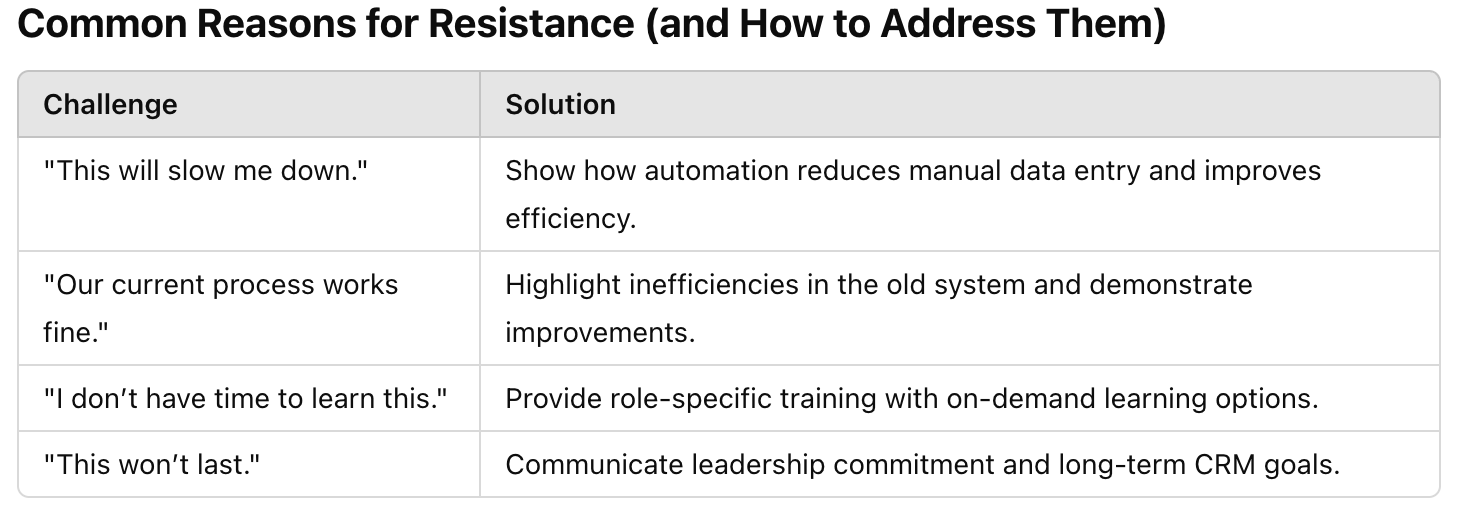Implementing a Customer Relationship Management (CRM) system is a major shift for any organization. A well-structured CRM—such as HubSpot CRM—has the potential to streamline operations, enhance collaboration, and improve customer relationships. However, the success of a CRM rollout depends on effective change management.
Without a clear strategy to introduce, reinforce, and optimize CRM adoption, companies often face challenges such as:
- Employee resistance to change due to unfamiliarity or fear of increased workload.
- Inconsistent CRM usage that leads to incomplete or inaccurate data.
- Lack of leadership buy-in, resulting in poor accountability and adoption.
This guide outlines proven strategies for managing change effectively when implementing a CRM. By focusing on communication, leadership, training, and continuous monitoring, businesses can ensure their CRM investment delivers real value.
Why CRM Change Management Matters
A CRM is designed to centralize data, improve efficiency, and enhance decision-making. However, if employees resist using it or fail to enter accurate data, its potential is wasted. Common obstacles include:
- Lack of clarity on why the CRM is necessary
- Concerns that the system will add complexity instead of streamlining work
- Uncertainty about how the CRM benefits individual roles
- Fear that performance tracking will increase micromanagement
A structured change management strategy ensures that:
- Employees understand the reasons behind the CRM implementation and how it supports their daily work.
- Teams feel confident using the system through clear training and support.
- CRM adoption is reinforced at all levels of the organization to create long-term engagement.
1. Overcoming Resistance to CRM Adoption
Resistance is natural with any new technology. Addressing concerns early helps build trust and enthusiasm for the CRM rollout.

Practical Strategies for Reducing Resistance
- Involve employees early in the process to gather input and increase buy-in.
- Demonstrate small wins by showing how the CRM simplifies daily tasks.
- Position the CRM as a productivity tool, not just a reporting tool to prevent concerns about micromanagement.
2. Communicating the Value of CRM Adoption
Clear, consistent communication is essential for getting teams on board with the CRM. Employees need to understand:
- Why the CRM is being implemented.
- How it will help them in their specific roles.
- What support they will receive throughout the transition.
Best Practices for CRM Communication
- Create a CRM vision statement that outlines the system’s purpose and benefits.
- Tailor messaging for different teams to highlight relevant advantages.
- Use multiple communication channels such as email updates, town halls, and team meetings.
Key Messages for Different Teams
- Sales teams: The CRM will help track deals, automate follow-ups, and prioritize the best opportunities.
- Marketing teams: The CRM will provide better insights into lead sources and campaign performance.
- Customer service teams: The CRM will streamline ticket management and improve response times.
Maintaining an open feedback loop allows employees to express concerns, ask questions, and contribute ideas for improvement.
3. Leadership’s Role in CRM Adoption
Leaders play a crucial role in driving CRM adoption. Employees are more likely to engage with the system if they see managers and executives actively using it.
How Leaders Can Support CRM Success
- Lead by example by consistently logging interactions, updating deals, and using CRM-generated insights in decision-making.
- Incorporate CRM metrics into performance reviews to reinforce accountability.
- Recognize and reward adoption efforts by highlighting team members who effectively use the system.
When leaders integrate the CRM into their own workflows, it sets the standard for the rest of the organization.
4. Training Strategies for Long-Term CRM Success
A single training session is not enough to ensure lasting CRM adoption. Employees need ongoing education to feel comfortable using the system effectively.
Best Practices for CRM Training
- Offer role-specific training that focuses on how each team will use the CRM in their daily tasks.
- Provide a mix of learning formats, including live workshops, recorded tutorials, and interactive guides.
- Create an internal knowledge base with FAQs, troubleshooting tips, and step-by-step instructions.
- Assign CRM champions—power users who can assist colleagues and reinforce best practices.
A well-structured training program prevents frustration and ensures teams use the CRM consistently and correctly.
5. Monitoring CRM Adoption and Addressing Challenges
Even after the initial rollout, regularly measuring CRM adoption helps identify gaps and areas for improvement.
Key Metrics to Track
- User logins and activity levels – Are employees actively using the CRM?
- Data entry consistency – Are leads, deals, and customer interactions being logged properly?
- Pipeline and deal tracking – Are sales teams keeping CRM data updated?
- Feedback from employees – What challenges are users facing?
How to Improve Adoption if Engagement is Low
- If employees aren’t logging in regularly → Provide additional training and reminders.
- If data is incomplete or inconsistent → Automate data entry where possible and enforce clear data entry guidelines.
- If users are frustrated with the CRM’s functionality → Gather feedback and adjust workflows to align better with team needs.
By continuously monitoring engagement and making improvements, businesses can ensure long-term CRM success.
Final Thoughts
Implementing a CRM is not just about deploying software—it requires a structured change management approach. By addressing resistance, communicating clearly, involving leadership, providing strong training, and continuously monitoring adoption, companies can maximize the value of their CRM investment.
The right CRM strategy leads to higher engagement, improved data quality, and increased efficiency across teams.
For businesses looking to optimize CRM adoption and user engagement, developing a customized change management plan is essential. If you need assistance in rolling out HubSpot CRM or improving adoption, contact us to explore how we can help.


